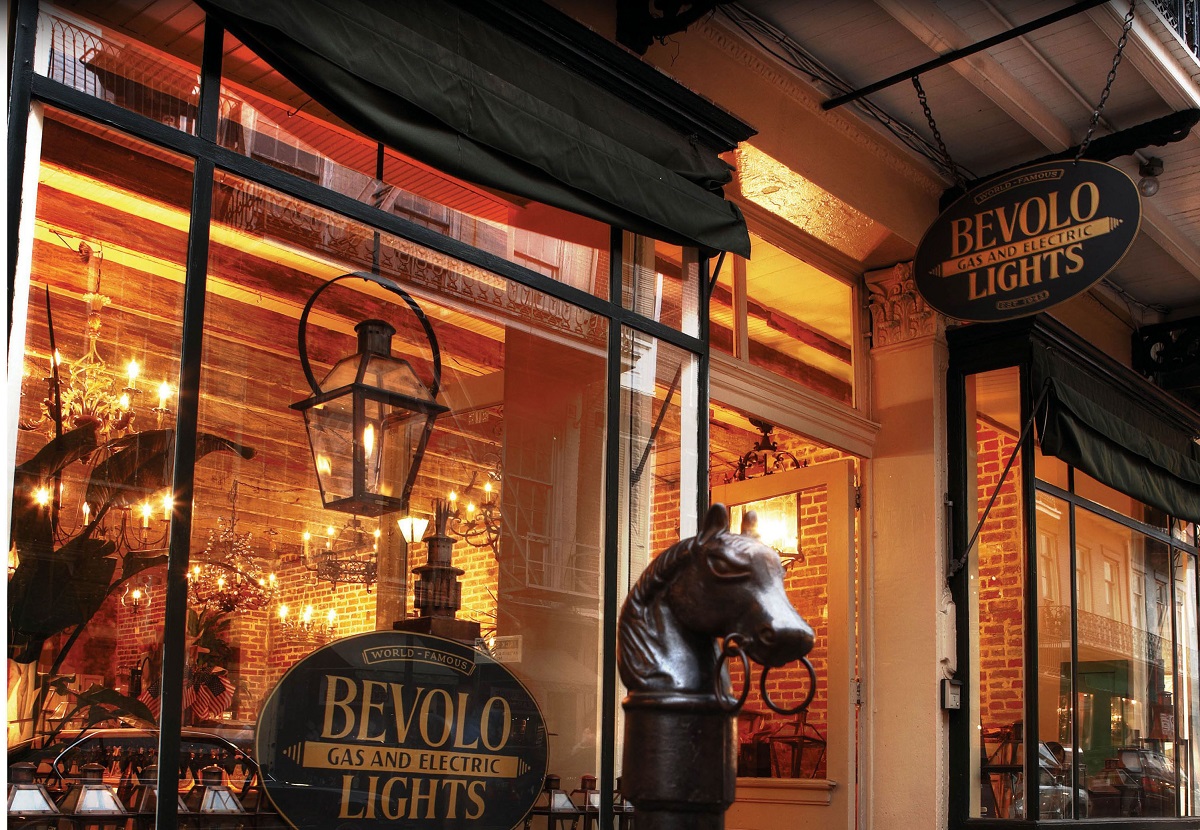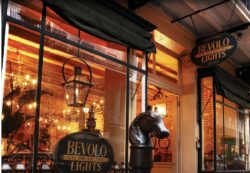Summer 2021
Lighting Up Louisiana
Bevolo celebrates seventy-five years
Published: May 28, 2021
Last Updated: June 1, 2023

Bevolo Gas & Electric Lights
Bevolo museum and showroom at 316 Royal Street.
The Bevolo lighting story began with founder Andrew Bevolo Sr., who immigrated to the United States from Italy as a teenager during World War I. He honed his metalworking abilities at Ford Motor Company and Sikorsky Aircraft. When World War II began, Bevolo moved to New Orleans to work for Higgins Industries, which manufactured the famous “Higgins boats” used in the Allied D-Day landing at Normandy.
Unfortunately, peacetime cost many Higgins staff their jobs, including Bevolo. In 1945 he opened his own metalworking business in the French Quarter with the slogan “We Metal in Anything.” Customers frequently brought him antique copper lamps with crumbling soldered joints. Using his aircraft knowledge, Andrew developed a riveting technique that preserved the structural integrity of the surrounding copper.
One fateful day, Andrew Bevolo received the commission that would change his life. Notable architect A. Hays Town was walking around the French Quarter and heard Bevolo hammering in the shop. Town asked if Bevolo could create a custom lantern design for one of his projects. Their collaboration produced the original Bevolo French Quarter lamp, which is now ubiquitous on the neighborhood’s historic streets.
The French Quarter lamp’s tapered four-sided design is reminiscent of New Orleans streetlights in the nineteenth century. English-born James Caldwell opened the area’s first gasworks in 1834, providing an alternative to older oil lamps that could be dim and unreliable. By the 1860s over twenty-five hundred city-owned gas streetlights illuminated the night, along with gas fixtures on private homes and businesses. Electric streetlights eventually replaced gas ones in the 1880s, but the attraction of vintage styles endured. Current French Quarter streetlights, installed in the 1920s, are replicas of the mid-nineteenth-century gas lamps.
Today Bevolo Gas & Electric Lights offers over five hundred different designs to match an array of historic and modern styles. “Each generation contributes as architectural needs arise,” said Drew Bevolo, the third-generation family owner. Architects inspired by A. Hays Town’s work, such as Ken Tate, Bobby McAlpine, and Andrés Duany, continue to commission Bevolo lamps.
Bevolo operations have expanded across the New Orleans area, with workshops on the West Bank and in Mandeville. Three French Quarter showrooms on Conti and Royal Streets showcase the range of exterior and interior fixtures available and offer antique home furnishings that complement lamp designs. The company recently started carrying colorful vintage mid-century modern glass lamps to meet that style’s current popularity.
By the 1860s over twenty-five hundred city-owned gas streetlights illuminated the night, along with gas fixtures on private homes and businesses. Electric streetlights eventually replaced gas ones in the 1880s, but the attraction of vintage styles endured.
Still, tradition remains the foundation of Bevolo inspiration. “We have an extensive antique book collection of architectural Louisiana, New Orleans, and French Quarter history,” said Drew. The Vieux Carré Commission photographic archives, Friends of the Cabildo publications, and the Williams Research Center at The Historic New Orleans Collection, as well as A. Hays Town publications, are other reference mainstays.
Bevolo coppersmiths’ painstaking dedication to time-honored techniques is what makes the difference in quality. According to Drew, “It takes two days to make a single fixture, but two years to learn how to make one.” To celebrate its seventy-fifth anniversary, the company launched a new “Maker’s Mark” feature highlighting their skilled staff. All Bevolo lamps now bear a unique mark of their maker’s initials next to the standard Bevolo tag and serial number. A “Get to Know Your Craftsman” page on the Bevolo website offers profiles of the men behind the Maker’s Marks, several of whom have prior experience in other manufacturing industries as the company’s founder did.
From its New Orleans roots, Bevolo has grown into an international business with customers in all fifty states and in sixty-seven countries. The company maintains its passion for American manufacturing with their materials, sourcing from Revere Copper in Michigan’s Upper Peninsula. “They’ve consistently made the purest copper sheets since 1802. When you use pure copper and put it together with copper rivets your products will last for hundreds of years,” said Drew. “We tend to see that many of our clients live in coastal environments… our pure copper and naval brass brackets will hold up to the brutal coastal environments.”
By blending historical methods with modern ingenuity, Bevolo Gas & Electric Lights has stood the test of time for seventy-five years. Honoring family legacies and contributing to the local community remain the heart of what they do. When asked about plans for the company’s future, Drew Bevolo said he looks forward to the day pandemic restrictions lift and the Bevolo workshop and museum at 316 Royal Street can reopen, once again welcoming visitors from across the globe to see a coppersmith’s skills firsthand.
Sarah Duggan is the Coordinator and Research Curator of the Decorative Arts of the Gulf South project at The Historic New Orleans Collection, which documents historic objects made or used in Louisiana, Mississippi, and Alabama prior to 1865. She is co-curator of the exhibit Pieces of History: Ten Years of Decorative Arts Fieldwork on view at THNOC through September 5, 2021.
